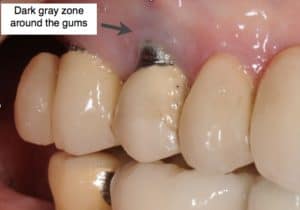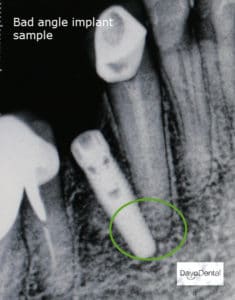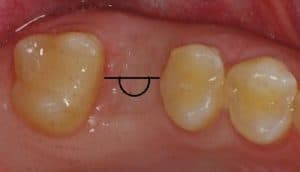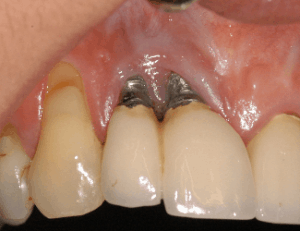
Dental Implant Problems and Complications
There are many common mistakes during implant surgery such as the implant can be placed into a nerve, sinus or even another tooth root. But if there is proper implant planning with a 3D cone beam x-ray, dental implant surgery is very quick, simple and there is minimal pain. Recovery from implant surgery in healthy patients is usually complete within one to two months and is uneventful. However when the patient is unhealthy or proper implant planning is not done, implant surgery can have problems and complications. The risks and complications of getting implants should be understood and carefully considered even though implants are a success 95% of the time.
Risks and Complications of Dental Implant Surgery

An Implant placed into a nerve or artery.
Never, never should a dentist do a dental implant unless a 3D CBCT cone beam X-ray has been taken. It just isn’t worth rolling the dice. Whether you need one tooth or a full mouth of implants, always take a 3D image. You cannot see the anatomy of the jaw bone without a 3D X-ray. Most large x-ray machines where you stand-up are 2D “panoramic” x-ray machines. A 3D CBCT is an expensive 100-200K piece of equipment only owned by specialized implant dentists and surgeons. Ask the dentist if they are taking a “cone beam 3D X-ray”. Placing a dental implant without a cone beam X-ray is like drilling into the walls of your house without knowing where the wires and pipes are located.
Implant can be improperly put into a sinus.
Again get a 3D X-ray. Implants can be placed around sinuses with proper management with a high level of success. It is called a sinus lift. In order to lift a sinus you need to know where it is and manage to lift it properly.
Implant not placed into the gum enough.
This will result in a tooth that appears too short due to decreased height available for the implant crowns. How would you like to have a short squatty tooth in your smile? A cosmetic dental problem only, but an ugly and embarrassing one.
Implant placed too far into the gum.
This may result in the tooth looking too long. It will also be more difficult to clean and the implant can get infected later.
Implant Infected after Surgery
Usually the result of a patient who does not take prescribed medications after implant surgery. Can also be due to unhealthy bone where the implant was placed. One other possibility is inadequate width of bone for implant placement or the implant placed at an angle where it came out of the bone at the bottom. The implant can also crack the bone upon placement, if the implant is placed under too much pressure and/or the bone is unhealthy and brittle. Note: not all these all the fault of the implant dentist, but maybe just a difficult or impossible clinical case.
Implant too close to an adjacent tooth.
this will result in the implant crown not being centered in between the teeth and you may get a lot of food stuck under the implant tooth.
Implant too far back towards the tongue.
This will result in the tooth being too thick on the tongue side and a large ledge under the crown on the cheek and lip side.
Implant too far towards the lips cheek.
This will result in the crown being too thick on the cheek and lip side and a large ledge being present on the tongue side.
The implant placed at the wrong angle.
This will result in off-angle biting forces and sometimes the crown being too thick on the over-angulated side.
Implant placed into the root of an adjacent tooth.
This may result in loss of the adjacent tooth and infection of the implant. Dental implant complications do happen. Dental implant problems can occur.


What Constitutes Proper Implant Position and Placement?
- Centered between the adjacent teeth
- Centered between the cheek
- Centered between lips and tongue
- Placed 3mm into the gum
- Angled into bone
- Angled to be as best as possible in line with biting forces
- Placed into healthy vital bone
What to do if there is an implant complication?
Early detection of implant problems is critical. When things do not seem right with a dental implant, they usually are not right. Implants heal very quickly and usually with minimal symptoms and no major incident. The best course of action when an implant is failing is early diagnosis of failure and speedy removal of the implant. If a failing implant is left in the jaw bone it will cause pain and bone loss at the very least. The failing implant can also potentially cause harm to other teeth and possibly a bad infection.
Meet Dr. Adams

Dr. Gary Adams has successfully placed thousands of dental implants. I will happily take a look at you implant problems and provide a diagnosis and honest opinion. We are a full service implant center and I am the only dentist you will need for you consultation in my office. We have a state of the art 3D Xray / Cone Beam imaging system specifically made for implant planning and diagnosis.

 (301) 421 1996
(301) 421 1996 burtonsvillesmiles@gmail.com
burtonsvillesmiles@gmail.com
